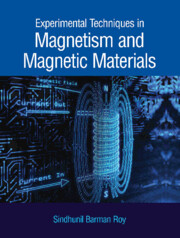Book contents
- Frontmatter
- Dedication
- Contents
- Preface
- I Introduction to Magnetism and Magnetic Materials
- II Basic Phenomenology of Magnetism
- III Experimental Techniques in Magnetism
- Appendix A Magnetic Fields and Their Generation
- Appendix B Units in Magnetism
- Appendix C Demagnetization Field and Demagnetization Factor
- Index
Appendix A - Magnetic Fields and Their Generation
Published online by Cambridge University Press: 27 October 2022
- Frontmatter
- Dedication
- Contents
- Preface
- I Introduction to Magnetism and Magnetic Materials
- II Basic Phenomenology of Magnetism
- III Experimental Techniques in Magnetism
- Appendix A Magnetic Fields and Their Generation
- Appendix B Units in Magnetism
- Appendix C Demagnetization Field and Demagnetization Factor
- Index
Summary
A magnetic field is called a steady field if the timescale of the increasing (or decreasing) magnetic field during an experiment is a few minutes or a few tens of minutes. On the other hand, if the magnetic field changes in a very short time, like milliseconds, it is called a pulsed-field [1]. Pulsed-fields with a duration of several hundred milliseconds up to several seconds are sometimes called long pulse fields [1].
Steady Field
Electromagnets are used if the magnetic field requirement is below 2 T. This is because of the saturation of iron cores used in conventional electromagnets. In 1933 the American physicist Francis Bitter introduced a design of an electromagnet to produce a higher magnetic field. This is known as the Bitter magnet where the current flows in a helical path through circular conducting metal plates stacked in a helical configuration with insulating spacers [2]. The schematic of a Bitter magnet is shown in Fig. A.1. The stacked metal plate design helps to withstand the Lorentz force due to the magnetic field acting on the moving electric charges in the plate. The Lorentz force causes an enormous outward mechanical pressure. The other important point in the design of Bitter magnets is about how to remove the huge amount of heat generated in this resistive magnet. This is achieved by flowing water along the axial direction through the holes incorporated in the stacked plates [1]. Bitter magnets are still used today to produce fields of up to 33 T at the National High Magnetic Field Laboratory (NHMFL) at Florida State University, Tallahassee, USA. Fig. A.2 shows a Florida Bitter disk from Tallahassee with highly elongated, staggered cooling holes. In more recent times a magnetic field of 37.5 T is produced at room temperature by a Bitter electromagnet at the High Field Magnet Laboratory in Nijmegen, Netherlands.
Superconducting magnets are more popular nowadays in laboratories worldwide to produce fields up to 20 T. A magnetic field of 7 T using Nb3Sn-based superconducting magnet was first generated in 1961 by Kunzler et al. [3], and the superconducting magnets that produced over 10 T became commercially available in the 1970s [1].
- Type
- Chapter
- Information
- Experimental Techniques in Magnetism and Magnetic Materials , pp. 319 - 324Publisher: Cambridge University PressPrint publication year: 2023



